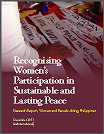Article from Isis International Manila publication we!, December 2005 issue
MYTH 1: Trade liberalisation will reduce poverty and is the only way to achieve development. Free trade will benefit all countries — whether developing or developed.
FACTS:
Even WTO and World Bank data show that many poor countries have been left behind in the free trade economy. Even as rich countries demand that poor countries open up their markers, the former have subsidised agriculture and blocked the latter’s access to their markets. These agricultural subsidies effectively destroy poor countries’ comparative advantage (which is often low labour costs, poor environmental regulations and lax labour standards).
According to the UN Commission on Trade and Development (UNCTAD), the world’s poorest countries – the 49 least developed countries – have not shared in the growth of world trade. In 2002, the 646 million people in the top exporting countries - the US, Germany, Japan, France and UK - have 100 times more trade than their poor counterparts (37% vs. 0.6%).
Unlike developed countries, many poor countries depend on a single primary export like wood, coffee, copper or cotton. But prices for such commodities have been declining. Prices of manufactured goods have, in contrast, risen in relative terms.Huge agricultural subsidies by Western countries to their small farm populations far outweigh the aid given to developing countries. Organisation for Economic Co-operation and Development (OECD) data show that the 30 most developed countries spent $305 billion in support to their own agricultural industries but gave only $50.6 billion development assistance to developing countries. The former have repeatedly pledged to reduce the size of their farm supports, but the amount of such subsidies has changed little in 20 years, while the amount of aid has declined.
Globally, the proportion of people in poverty has declined, but as the population grows the actual number of poor people is still rising. More than 1 billion people still subsist on less than $1 a day. Of these, 7 in 10 live in Asia.Various studies have revealed that global trade liberalisation policies have disastrous impacts on food security and sovereignty, industry, employment, the environment, livelihoods and the access of millions of people to essential services, technology and health-care.
Alternatives to WTO and its one-size-fits all trade liberalisation policies exist. A pluralistic system of governance formed on the basis of subordinating trade to development needs and on promoting gender and social justice, and where an effective system of checks and balances operates, will best serve the needs of developing and least developed countries.MYTH 2: Gender has no place at the trade negotiating table. Free trade will benefit both women and men equally.
FACTS:
Trade and investment policies are neither gender blind nor gender neutral in their impact on the lives of women.Women and men experience poverty differently, have unequal access to and control over resources, do not enjoy equal protection of human rights, and have distinct productive and reproductive roles. This means trade policies affect them differently.
While trade liberalisation has resulted in job losses and welfare erosion across the board, the brunt of their negative impacts have fallen on women. Women make up more than half of the work force in agriculture, industry, and services in many countries but receive lower remuneration, are subjected to worse working conditions, are less protected by labour and human rights codes, and face greater job insecurity than men. Indeed large numbers experience outright exclusion from the labor force, leading to the forced-migration of many.UNIFEM’s Progress of the World’s Women 2005 Report reveals that women are concentrated in more precarious forms of employment in which earnings are low. Women are increasingly at risk of working in highly exploitative and dangerous conditions. Trade liberalisation tends to increase women’s employment in the industrial sector, in commercial agriculture and in export processing zones, which are characterised by low pay rates and sub-standard conditions. Globalisation has also fueled informal employment arrangements and subcontracting in female-dominated industries (e.g., food and garment production), threatening the security, status and rights of workers.
Trade liberalisation policies have pulled many women into the formal labour force while at the same time affecting the cost and availability of food, medicines, household goods and social services. These often increase the burden of social reproduction for women. Even as women have less time available for caring for the family and the community, they face greater demand to provide these services. Regrettably, studies show that men are not stepping in.Some governments overtly appeal to sexism to increase their country’s trade revenues (e.g., using low wages of women as a basis to compete internationally in export industries or through campaigns to encourage married women to do home-based work).
Gender-based inequalities, especially in education, health and training, hinder women’s abilities to take advantage of new opportunities created by trade liberalisation such as skilled employment and entrepreneurial opportunities. In countries where institutionalised sexism and biases still block women’s access to land and credit, trade policies may reproduce these biases or introduce new ones.
Sources:
AWID. August 2002. “Women’s Rights, the World Trade Organization and International Trade Policy.” Facts and Issues: Women’s Rights and Economic Change. No. 4. <www.awid.org>
Chen, Martha et al. 2005. Progress of the World’s Women 2005: Women, Work and Poverty. NY, USA: UNIFEM. <www.unifem.org>
BBC News. “At-a-Glance: Poor Countries and Trade.” <news.bbc.co.uk>
Focus on the Global South. 2005. The Derailers’ Guide to the WTO. <www.focusweb.org>
International Gender and Trade Network (IGTN). 2005. IGTN at Hong Kong: WTO 6th Ministerial Meeting Hong Kong, China; December 13-18, 2005. Rio de Janeiro, Brazil: IGTN. <www.igtn.org/page/641>




 The
The 
 Isis Resource Center holds one of the largest feminist collections of materials in the Global South. With 40 years of publication experience, Isis holds a vast collection.
Isis Resource Center holds one of the largest feminist collections of materials in the Global South. With 40 years of publication experience, Isis holds a vast collection.